Bio:
Monegar, Clarence Boyce
Contact: Stan
----Source:
Pat (Susa) Sievers
Surnames:
Clarence Boyce Monegar
Written by
Pat (Susa) Sievers.
Christ Keiner watched Clarence Boyce
Monegar leave his grocery store carrying one less rolled watercolor under his
arm and $5 more in his pocket. The rolls sliding, almost falling out of his
elbow grip, Clarence managed to get past the grocer’s butcher case without
bumping into it this time. He was in a hurry, Christ knew this because, for as
nice mannered and soft spoken the man was, it never changed - the minute the
money got into his hand his eyes lit up and a sense of urgency seemed to
overtake him.
Christ also knew that his own family
especially Hugh, his son-in-law, would be upset with him for buying yet another
of Clarence’s watercolor landscapes. Hugh said he was enabling a damned bad
habit but Christ always held out hope that maybe just once Clarence would take
the money home to his wife Tilly to put food on the table for their five kids.
But likely as not Clarence’s next stop would be the tavern two doors down.
Clarence was a talented man but alcoholism made his life story a tragedy.
Clarence Boyce Monegar was a Native
American Indian. He was born in Wittenberg, Shawano County, Wisconsin on April
10, 1910 into a family that knew desperate poverty. His father provided for the
family by working in the cranberry marshes. Then, the 1918 influenza pandemic
invaded the country, wiping out many in the Winnebago tribe including Clarence’s
father and four siblings. Clarence, his mother and two brothers, Joseph and
Russell survived. All three brothers demonstrated exceptional artistic talent
but Clarence stood out. Perhaps because he was the oldest, his mother
encouraged and taught him as he watched her design, weave and decorate baskets.
The Reverend T. M. Rykken was
impressed with Clarence’s drawing ability while he was a student at the
Parochial Indian School in Wittenberg and arranged for him to attend the Indian
School in Tomah. It was there that Clarence studied with an art teacher, Miss
Crane. It was his first formal training in the fundamentals of drawing, and he
excelled. His paintings exhibited great attention to the smallest detail
whether a scar or wrinkle in the face of an Indian Chief or the subtle colors
and patterns of feathers on a pheasant. He returned to Wittenberg for high
school but dropped out after the first year to help support his mother and
brothers.
Drawing and painting did not put food
on the table and Clarence’s passion for art died while he chopped wood, picked
cranberries, worked at any job he could find.
But hardships and poverty could not
be overcome by chopping wood. At 16, Clarence ran away with a circus. He
performed as part of the Wild West show that traveled throughout the country,
and within six months he was in California. Clarence had never been so far from
home and never missed it so much. He hopped a freight train that was going east
through small towns and big cities, around and through hills, over rivers and
across roads, through forests and over plains. At no other time did Clarence
feel so close to Mother Earth as when he clung to the top of the train car,
lying flat on the roof. Clinging with his fingers to the edges, he could feel
the brush of every low hanging branch as the train swayed along the tracks. He
was sure he would be scraped off as the train chugged through tunnel after
tunnel. When he finally got back to Wisconsin he declared that he had "gotten
the circus out of his system."
Back in the Black River Falls area
Clarence found work as a sign painter. As the community grew, Clarence’s
designs and drawings showed up on store fronts and truck doors. His reputation
as a creative artist grew by word of mouth. It was a living. In 1932 he
married Emma Stacy, the daughter of a prominent Indian family. Encouraged by
Emma, he once again dabbled in drawing. Their family thrived until catastrophe
struck Clarence’s life once more. Emma contracted tuberculosis and passed away
in 1942, leaving him with four young children to care for. The responsibility
of a family was overwhelming for the young Native American man and he drifted.
The grocery
store lights went off. Christ was locking his front door ready to walk
home. His daughter, Frieda would have supper waiting for him. As he stepped
down from the stoop, he spotted Clarence weaving down the sidewalk and suddenly
collapsing against the red brick wall of the bakery. It looked like there were
about half a dozen rolled paintings left laying on the ground, some under
Clarence’s body as he hung tightly to the brown bag that he brought up to his
mouth for another swig. Christ shook his head at the shame of the wasted man
and his wasted talent. Christ carried the latest picture he had bought from
Clarence of a wolf skulking toward a snowy den, stealing a last look at whatever
marauder it eluded. Frieda would fuss about him throwing his money away but the
art was good and who knew, maybe one time Clarence would take money home to
Tilly and the kids. Christ walked briskly wanting to feel the warmth of his
home and to also listen to the war news. It was clear WWII was on the horizon.
There were sad and horrible changes in store for all Americans.
Traditional tribal custom sometimes
dictates replacement marriages and Clarence would have married Tilly Stacy,
Emma’s sister under this tradition. Also, Tilly’s sense of loyalty to her
sister and her sister’s children would put her in a position of accepting
Clarence as a husband. She loved the children and provided a home for them.
Clarence deserted his family, leaving them at a time when they needed their
father the most. He lost his job as a sign painter, drifted, drank and didn’t
support his children or his new wife. Complaints landed him in the Neillsville
jail for non-support of his kin and public drunkenness.
To pass the time in jail, Clarence
penciled sketches of wild life scenes. His jailers, the sheriff and the
district attorney watched in wonder at his ability and provided him with paints,
brushes and paper. The district attorney was so awed with the art work that he
had Clarence paroled into his own care and drove him to UW-Madison to see the
noted regionalist artist, John Steuart Curry, artist in residence, in hope that
Curry would recognize Monegar’s talent and help turn his art into a lucrative
occupation. Curry was so impressed that he wrote to his dealer, Reeves
Lowenthal of Associated American Artists in New York. Curry introduced Monegar
to lithography and it was his painting named Feeding Grouse that the
dealer accepted and sold in an edition of sixty. Curry was no longer teaching
but did mentor Monegar, introducing him to the annual Rural Arts Show at the
University. Whatever art Clarence submitted was sold. During this time
Clarence started to sign his drawings with his name and to also draw a very
small arrowhead after his name to signify his Native American culture in a
predominantly Euro-American audience. This all came to an end in 1945 when
Clarence Monegar was drafted into the army to serve as an ambulance driver.
Clarence returned to Black River
Falls in May, 1946. His wife, Tilly was in Greenwood, caring for his four
children as well as her and Clarence’s son, John who was born in 1944. The
Black River Falls tribal office staff helped complete the paperwork for his
military discharge, provide for financial aid and re-establish a relationship
with tribal members. Once he finished these formalities Clarence stayed in the
area for a very short time. His children didn’t know him and Tilly didn’t need
another mouth to feed. Fatherhood and family responsibility were not part of
Clarence’s vocabulary and he again deserted his family. Clarence reverted back
to his earlier pastime of drinking and drifting, painting and peddling.
The next step in his career was to
attend the Chicago Art Institute on the G.I. Bill. He studied there long enough
to redefine his water color techniques as well as gain a better knowledge and
understanding of other art mediums. He was introduced to silk screening while
working briefly with a commercial art company, but lithography continued to be
his specialty.
Clarence’s painting changed very
little over the course of his life. A July 6, 1969 article by Journal Art
Editor, Donald Key, describes Clarence’s paintings: "His views of running deer,
of wild geese or ducks rising from the water, of fish breaking and dancing in
open air to escape the creel of an opponent have the energy, the splash, the
recollections of the sounds and scents from forests, lakes and streams. Even a
fox crackles a twig in "The Chase". Clarence’s trademarks were a large white
birch tree, flying grouse and marsh grass.
The Bureau of Indian Affairs paid
Native American Indians to produce artistic products that were racially
stereotyped. Clarence’s painting didn’t fit into that Euro-American labeled
niche. Indians from each section of the country were noted for their individual
specialties. Pottery, weaving, silverwork, kachina dolls, sand painting, masks,
totem poles, and in the Midwest, the Woodland Indians, of which the Winnebago
were a part, were noted for their skill in bead work and basketry, fashioned
from the wood of ash and beech trees. Indians told the stories of their
heritage verbally. When white settlers appeared, Indians were expected to
assimilate and in the process were stripped of their own language. Native
American Indian records of battles were documented in the white man’s lined
ledgers in the form of drawings and done at the command of the U.S. military.
The closest Clarence Boyce Monegar’s drawings would come to any Indian ethnicity
would be his possible familiarity with ledger drawings. The Winnebago did not
particularly value or appreciate a talent for painting or drawing of pictures,
landscape or wildlife.
It is questionable whether Clarence
himself valued his drawings as anything more than a means to a bottle of booze.
He lived from drawing to bottle during an era of national economic hardship.
Some people recognized his talent and took advantage while others bought his art
thinking they were helping him earn a living for his family.
An article by R. A. Scott,
Wisconsin Artists and Their Work describes Monegar’s work:
"Although he is primarily a wildlife
artist, working with water color, occasionally he does work in pastel, but only
when doing portraits, particularly of Indian personalities. He is also a highly
prolific artist who will turn out as many as five watercolors as day, ranging in
size from 10" by 15" to 20" by 30". When he begins a painting, everything is
planned for speed. Since he uses the "wet method" speed is a must (27)."
The audience for wildlife paintings
and in particular those labeled "Indian paintings" was dwindling and Clarence’s
mentor Curry was gone. Clarence left Chicago, spent some time in Milwaukee and
went back to Black River Falls. He grew away from his people. His children
would not talk to him or about him. All he had left was talent and alcohol. He
continued his drinking, drifting, painting and peddling lifestyle. He would
paint in the attic of his house in Black River Falls, or if he was in Milwaukee,
at his flat near Layton School of Art.
It is estimated that, over the course
of his life, he painted over 8,000 pictures and peddled them all himself going
door to door, shop to shop, tavern to tavern and then he drank the profit. Even
though Clarence wore glasses, by the end of his life he painted using a
magnifying glass. He was able to maintain the minute detail he was noted for
but some of his paintings appeared incomplete, such as a glorious fox without
its tail.
Clarence married again and had five
more children. He remained married to his third wife, Melba until his death,
July 16, 1968 at the age of 58. It is said that Clarence’s family was never
able to afford to frame even one of his paintings and Tilly, the woman his first
five children called Mother, kept none of his paintings.
Although he had some early lessons,
Clarence was essentially a self taught artist. Gifted with a photographic
memory, he had initially been trained by his artist mother in the way of their
culture. She taught Clarence to observe keenly, pay acute attention and always
be watchful. Indian culture rewarded these traits. Despite the distinctive use
of color and compositional detail he exhibited, it still remains that he was
caught in Euro American artists’ attitude that Native American artists needed to
paint within the Native American Indian romantic niche.
Clarence Monegar’s work is recognized
for his white birches, pines, wildlife and fowl. Huetta Manion, Director of
Landmarks Gallery in Milwaukee, WI said that Monegar produced at least two
Indian Chief paintings. Also, an anonymous woman who at one time owned over 30
Monegar paintings commissioned him to do a Hawaiian seascape which turned out to
be as beautifully detailed as his usual genre. Manion also told of having seen
a farm picture that included cows that someone must have asked him to paint.
Early in his life he painted portraits of the Van Gordon family, prominent
citizens of Clark County. What has become of all these paintings is not known.
Some hang on the walls of hunting shacks and lake cottages, and some are in the
galleries of collectors and sadly some have been destroyed.
His art survived his tragic life and
jail. The Memorial Exhibition of Winnebago Indian is a Tribute to
Indomitable Nature article by Donald Key, Journal Art Editor at the time
announced in the July 6, 1969 edition: "The first major exhibition of his work,
about 70 watercolors borrowed from collections from throughout Wisconsin opens
with a reception at 7:30 p.m. Wednesday at the Charles Allis Art Library, 1630
E. Royal Pl. ………His show will open on July 16, 1969 first anniversary of his
death."
Bibliography
Barton, John R.
Rural Artists of Wisconsin. Madison: University of Wisconsin Press,
1948.
Key, Donald. "His
Art Overcame Tragic Life and Jail: Memorial Exhibition of
Winnebago Indian
is Tribute to Indomitable Nature." Milwaukee Journal 6 Jul. 1969.
Scott, R. A.
"Clarence Boyce Monegar--Wisconsin Artist." Wisconsin Tails and Trails
4 Nov. 1963.
Watson, Samuel E.
"The Hunt for Identity in Clarence Monegar’s Wildlife Paintings. "Painters,
Patrons, and Identity. Ed. Joyce M. Szabo. Albuquerque: University of New
Mexico Press, 2001. 141-61.
Brown, Rae.
Personal interviews. January - April, 2007 (Ms. Brown was the last wife of
Byron Prescott, Native American Winnebago man)
Kaisler, Carol
Serverson. Personal and telephone interviews. January - April, 2007 (Mrs.
Kaisler is the owner of an original Monegar painting and granddaughter of Christ
Keiner)
Lurie, Dr. Nancy
Oestreich. Telephone interview. March 1, 2007 (Dr. Lurie is Anthropology
curator Emerita at Milwaukee Public Museum and author of a number of books about
the Winnebago Indians.)
Manion, Huetta.
Telephone interview. March 26, 2007 (Ms. Manion is director/owner of Landmarks
Gallery, Milwaukee, WI.)
Monegar, Russell.
Personal interview. March 4, 2007 (Mr. Monegar is the youngest brother of
Clarence Boyce Monegar)
Riola, Martha
Monegar. Telephone interview. March 27, 2007 (Mrs. Riola is the daughter of
Clarence Boyce Monegar)
Album of Clarence
Boyce Monegar's Artwork
#1
#2
#3
#4
#5
#6
Artwork Contributors
Mike Boyce #15
Carol (Severson) Kaisler.
Mark
Fyfe
Greenwood Library
Pat Braun © Every submission is protected by the Digital Millennium Copyright Act
of 1998. Show your appreciation of this freely provided information by not
copying it to any other site without our
permission.
Become a Clark County History
Buff
A site created and
maintained by the Clark County History Buffs
Webmasters: Leon
Konieczny, Tanya Paschke,
Janet & Stan Schwarze, James W. Sternitzky,
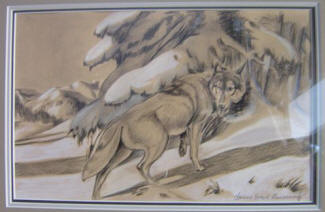
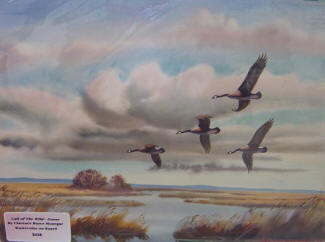
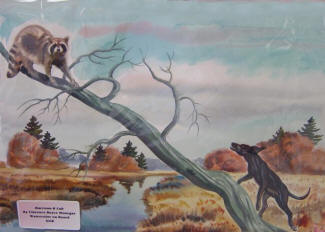
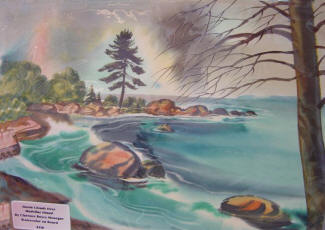
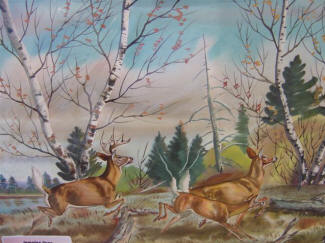
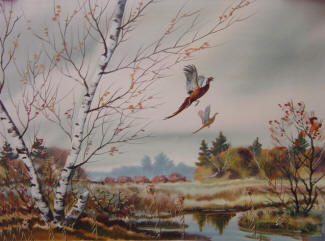
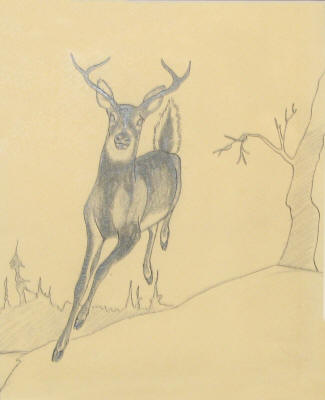
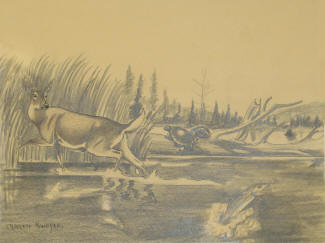
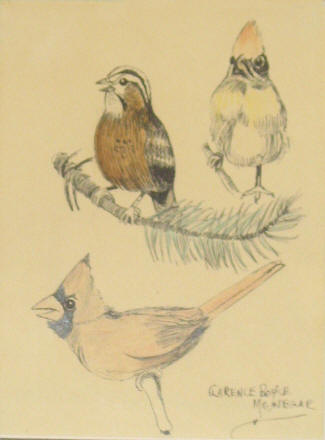

and supported by your generous donations.